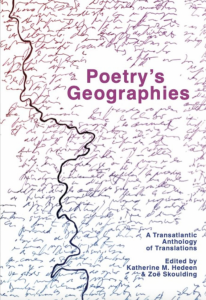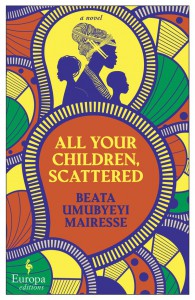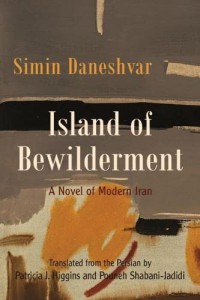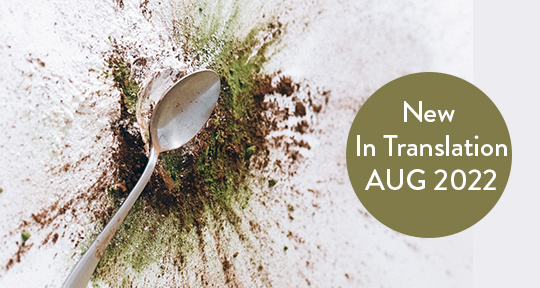As the world reverberates with the powers and consequence of language, this month’s round-up of translations are especially resonant with their assertion of how texts can subvert, heal, and ascribe meaning to life. Below, find reviews of a text that gathers poetry and its translators in boundary-defying dialogues of methods and ideas; a novel that powerfully uses silence to address the transgenerational trauma of the Rwandan genocide; and a sensitive story of an Iran on the precipices of change by celebrated modern novelist Simin Daneshvar.

Poetry’s Geographies: A Transatlantic Anthology of Translations, edited by Katherine M. Hedeen and Zoë Skoulding, Eulalia Books, 2022
Review by Laurel Taylor, Assistant Managing Editor
How does one review a translation (or rather a set of translations) which center the translator? This is the question I’ve been asking myself as I make my way through Poetry’s Geographies: A Transatlantic Anthology of Translations, edited by Katherine M. Hedeen and Zoë Skoulding. This ambitious collection is unique in bringing together translation practitioners from the heart of the Anglosphere and giving them a space to speak about their practices—what Hedeen might describe as “countermapping,” what Don Mee Choi might describe as “lilymethod” mapping, and what Erin Moure might call “in”mapping.
As you may have gathered from this description, Poetry’s Geographies begins not with the text-in-translation but with the translator, with their essays and methods which speak in sometimes contradictory, sometimes complementary dialogues. Through these, we, the readers, are asked to sit with the very contradiction of translation itself—the notion that one language can be “deformed” or “twinned” or “exploded” into another. Indeed, the acknowledgement of this impossibility, the greatest and most repeated cliché concerning poetry and translation, drives the collection. As Skoulding writes in the introduction, “Rather than making the world more transparent and ‘accessible’ for quick consumption, poetry and its translation can sustain opacité…as an opaqueness that allows the Other to exist in full, not to be reduced or subordinated.” Put differently in the essay from Sasha Dugdale:
I stand against this idea of translation as a vitrine in which we see the original. I stand against it here, me, many kilos of proteins, lipids, water, with a slow local history of my own composition and concurrent decomposition (I see also that it is a grave act to scribble in these lines)
no person is a pane of glass no person is of pure intent no person is devoid of history
In this approach, the notion of language as a window is cast aside. Language is smoke and mirrors (me). Language is air (Ziba Karbassi). Language is sound (Skoulding). Language is an infestation (Moure). Language is a sufism (Stephen Watts). Poetry’s Geographies asks us to stare into the mist and watch the swirling shapes, the fleeting shadows, the forms familiar, menacing, and absent. The thing we perceive, in Hedeen translating Victor Rodríguez Nuñez, may in fact be absence:
your existing is not shaped
from the knot that resembles the foliage weave
your being is not shaped
from the board sanded down by countless downpours
barely the keyhole owl eye
to look inside so nothing was left outside
an image in heatfertilized by the void
But the void is also the cradle of the Big Bang, the nursery in which everything is possible, including intimate connection. In the section where Watts and Karbassi translate Karbassi, for example, the poem “Diwan Under Snow” ends:
Death would drown in its own shy sweats
this death if it had feet would flee
if it was human & had a head would bang its head on a tree
or like a stranger-poet from its forearm would fashion a balalaika
and strum it naked under the snows
balalaika balalaika bailalaila lala-lailai laila-la-lai la-lai lie now
sleep now my lai-lai
my little one
my bairn
When reading this section, for a moment, I found myself swaying and dancing. For a moment, I found myself singing a half-remembered tune from high school, a Hebrew love song. In this translation which is “a ‘love’ that is a befriending, a sharing through the empathy of friendship,” love found me as well, amidst Persian, Russian, Hebrew, English, all resonating with what Watts calls “a sort of ur-language”: “I think that perhaps dance and some form or sense of music may pre-date language, in which case it is quite likely that poetry also perhaps pre-dates language, and such poetries as pre-date language might be thought of as residing in our experience at a level of ur-language.”
Kareem James Abu-Zeid points out in his essay that the silhouettes of poetry noted thus far can and indeed must coexist. “According to a non-dual translational poetics…the translator, like the poet, and as poet in their own right, is both nothing and everything. It is good to suspend intellectualization here, and to start to intuit things, as far as that is possible, because this is a space of paradoxes and seeming contradictions.” This is to say that Abu-Zeid acknowledges the material power of, for example, the label “Egyptian-American,” even as he opposes its nationalist and fictional constructs. In another light, we might conjoin this to Choi’s “radical twin”: “From where I am, a translator’s ears must be ever ready to shift from lilyears to lilyyears, or even pigears. Not opposite of that. My ears must remain in flight within and without the veil, the hailing napalm, the vertigo of language. Not opposite of that. Liliness is a must, rain or snow.” The translation must find a landing from which it leaps not in the direction of perfect, colonial understanding but in the direction of anticolonial “metamorphic sublime”—to refract Johaness Göransson refracting Michael Taussing refracting Walter Benjamin. This nothing and everything across the collection, setting in paradoxical companionship, manifests in Göransson’s “living experience” of Eva Kristina Olsson:
Nothing is everything
you are afraid
don’t be afraid
Don’t be afraid. Be afraid. Intuit in this collection the shape of things whole, broken, unseen, seen, vibrating at a frequency heard through lilyears and lilyyears, untranslated and intranslated and translated and poeted.

All Your Children, Scattered by Beata Umubyeyi Mairesse, translated from French by Alison Anderson, Europa, 2022
Review by Alyea Canada, Assistant Editor
Silence is powerful. It creates spaces where loss looms and trauma can thrive, all while perpetuating their incredible transmissibility. In her debut novel, All Your Children, Scattered, Beata Umubyeyi Mairesse explores this effect of silence and trauma through three generations contending with the genocide in Rwanda and its ramifications. The story mostly unfolds in shifting points of view between Immaculata, a Tutsi mother who hid in Rwanda during the genocide and, in a way, lost both of her children; and Blanche, her mixed-race daughter who was sent to Bordeaux, France, to escape the genocide. A few sections are also devoted to Stokely, Blanche’s son, who is struggling to find a place between the two countries of his mother. The resulting work is a beautiful and moving depiction of a family reaching for each other across years of separation and the weight of history, as they try to speak the silences lying between them.
The bulk of the book is devoted to Immaculata and Blanche as they try to reconnect upon Blanche’s return to Rwanda, and as their relationship is revealed, we are also introduced to Bosco, Immaculata’s son and Blanche’s half-brother, who fought with the Rwandan Patriotic Army during the genocide and struggles with the invisible wounds of war. No one in the family talks about their experience of the genocide or the aftereffects of the violence, and the novel similarly refuses to indulge in much discussion of what happened. Instead, Immaculata’s chapters deal mostly with her life prior, revealing the truth of her children’s paternity—a story that is inextricably tied to French colonialism; Blanche’s chapters describe the after of the genocide and her intense survivor’s guilt, which keeps her from Rwanda for seven years. At first, I found it frustrating that Mairesse mostly leaves the immediate experience of the genocide unspoken, but then I found myself questioning why I felt like I needed to know the specific details. While I’m sure a frank discussion could be healing for the characters, it would simply be voyeuristic for the reader. The question of when bearing witness becomes exploitation is briefly addressed in a scene between Immaculata and Blanche’s husband, but for the most part, the reader is left to grapple with these feelings on their own.
The silences between the characters are also present within the pages. We don’t know who these characters were before the genocide, and thus we don’t know what they are trying to rekindle. In many ways, Blanche and Immaculata also seem unsure of what they are trying to build: “How did we speak to one another, before? I seem to have forgotten. Which before did I want to return to, anyway? There were two of them. No, three.” This overarching silence is given further presence when Immaculata literally stops speaking after another tragedy befalls the family, and Blanche begins to fear that she is losing her native language of Kinyarwanda as she attempts teaching it to Stokely. The idea of language as being closely tied to motherhood (the very idea of a “mother tongue” is questioned at one point in the novel) is explored through Blanche and Immaculata’s relationship to their own languages and voices, illustrating the burdens of history that mothers often bear. Immaculata reflects on how, upon entering secondary school, she was forbidden from speaking her native language—if one were to be caught speaking Kinyarwanda, it was met with ridicule from both the white teachers and classmates. The legacy of colonialism, then, is inextricably tied up in the very languages these women are passing to their children.
There is something almost epistolary about the structure of the novel, with Blanche and Immaculata’s chapters speaking to and reaching toward each other across time. Because Immaculata mainly discusses the past and Blanche the present, the novel doesn’t follow a linear timeline; instead, its temporality shifts, with Stokely’s birth and Immaculata’s silence providing temporal anchor points. It is a structure that requires attention, but is reflective of the non-linear way that history unfurls into the present. While it took me a minute to adjust, I eventually found a flow between the narratives and the world they built. The chapters don’t necessarily correspond specifically, but thematically; Blanche discussing falling in love with her husband is followed by Immaculata discussing the first time she met Blanche’s father. It is a formalistic choice that Mairesse uses to indicate the struggles of these women, as they pursue different paths to get back to one another.
While Blanche and Immaculata speak in the second person—further contributing to the feeling that they are writing to each other—Stokely’s chapters are entirely in third person, underscoring the in-betweenness of his identity. Stokely, named after an American Black Panther, is being raised in France by an African mother grappling with survivor’s guilt and a West Indian father with his own family trauma. At times, every choice he makes feels like a declaration of allegiance—for example, his desire to play the clarinet rather than the more traditional instruments of Black jazzmen. While it’s clear that Stokely will become the catalyst for Immaculata and Blanche’s reconnection, his own journey to reconnect with his mother’s history is also pivotal, speaking simultaneously to the racism inherent in contemporary French society and its insidious valuations of privileging certain kind of victimhood over others on the world stage.
In a novel where language is so integral, Anderson’s skillful work stands up to scrutiny. She does an excellent job of balancing the chorus of voices, ensuring that they remain individual and distinct. In this multiplicity, All Your Children, Scattered is a brief but powerful novel about the weight of silence and the intergenerational nature of trauma, and despite the weight of its subject matter, there is a light at its center. In opening up these various narratives, Mairesse’s work acts as a reminder that even if the past cannot be restored, silence does not have the last word.

Island of Bewilderment by Simin Daneshvar, translated from the Persian by Patricia J. Higgins and Pouneh Shabani-Jadidi, Syracuse University Press, 2022
Review by Samantha Siefert, Marketing Manager
Iran in the 1970s was swirling with anticipation. New ideas, wealth, and power were flowing into the country just as quickly as oil was seeping out. British and American businesspeople were moving in with their families while young Iranians were moving away to chase education and opportunity abroad. Along these currents surged a great number of pathbreaking isms—spiritualism, feminism, communism—and in their wake, a national conversation emerged around questions of ideology and identity: what would be the future of Iran? To what extent should external forces define its destiny?
These dialogues lay the framework for Island of Bewilderment, the classic novel by Iran’s first major female novelist, Simin Daneshvar. Originally published in 1993, the text is now available in a new translation by Patricia J. Higgins and Pouneh Shabani-Jadidi. Set amidst vibrantly bustling Tehran in the years prior to the revolution of 1977–9, Daneshvar masterfully brings to life a diverse cast of characters, all in active pursuit of the philosophical and practical answers to these questions.
Our primary frame of reference in this search is that of protagonist Hasti Nourian, a modern, bourgeois woman who is twenty-six, unmarried (nearly a spinster!), an artist (a decent profession, for a modern woman), and employed by Iran’s Ministry of Art and Culture (a cushy, if ethically questionable, government job). The novel’s initial momentum and fundamental plotline stem from Hasti’s romantic life—the difficult choice between remaining with her longtime boyfriend Morad, who is political and committed to revolutionary change, or marrying Salim, the more traditional, spiritually-focused match her mother has arranged.
Marriage in Iran is a family affair, and when we first meet Hasti, she has agreed to visit her mother’s new, western spa to be introduced to a friend with an eligible son. Hasti has agreed to the setup because her mother is important to her, but defends her current boyfriend, Morad: “He’s the only man I know who will not exploit me […] He makes it possible for me to be the new woman that I want to be.” Hasti’s grandmother is equally invested in the match; despite approving of both suitors, she enthusiastically prepares her home to facilitate the new arrangement. Hasti’s courtship leads us into all corners of Tehran, from discussions with her intellectual circle at the university to political activism in the slums, contrasting her mother’s contemporary neighborhood with the more traditional home of her grandmother. Daneshvar achieves an unparalleled richness by weaving this relatively germane love triangle into this larger tapestry of characters, bringing the urbanity of Tehran to life.
The complexities of these three women and the worlds they inhabit paint a captivating picture of the generational changes taking place in Iran. To Hasti’s declaration of being a “new woman,” her mother asks: “There are new and old among women?” This act of specifying the change makes it tangible, allowing readers to feel the deliberate, urgent soul-searching these women experience. In a unique move by Daneshvar, both Hasti’s mother and grandmother have chapters devoted to their own individual inner lives and turmoil. We see Hasti’s struggle to be a “new woman,” but we also dive deep into the challenges her mother faces within her ritzy social circle of foreign diplomats, in addition to sharing in her grandmother’s more ascetic emotional battle to reconcile the painful loss of her martyred son.
The different perspectives expressed were likely familiar and personal to Simin Daneshvar, who was born in 1921 and writing in 1993. Daneshvar chose to live her whole life in her country even as other intellectuals relocated to Europe or the United States after the Islamic Republic was established, stating in an earlier novel’s letter to the reader: “I wanted to stay home to be a witness of my own time and place, and give testimony in my writing.” All of Daneshvar’s novels fall into the category of historical fiction in this way, making use of her personal experience to analyze pivotal moments of Iran’s history. Island of Bewilderment is an exceptional example, and even goes so far as to include Daneshvar as a character. She appears as one of Hasti’s professors and close mentors, and many of her contemporaries achieve mention as well; Daneshvar’s husband Jalal Al-e Ahmad, the political theorist Khalil Maleki, and writer Gholam-Hossein Sa‘edi are all given reference. These autobiographical features contribute to the overwhelming sincerity of the novel, putting readers directly proximal to real-life Iranians in the 1970s, discussing these ideas in earnest.
As a translation, Island of Bewilderment is most welcome, if not long overdue, in bringing these discussions to new audiences. Patricia J. Higgins and Pouneh Shabani-Jadidi moved in the social circles of 1970s Iran at the same time as Daneshvar, and in their introduction, they highlight their appreciation for the verisimilitude Island of Bewilderment creates for its sense of time and place through the actions and opinions of its characters. The thoughtful cultural notes they provide serve to broaden that familiarity.
Readers knowledgeable of Iran’s history will appreciate the unique qualities of Daneshvar’s work, while readers new to the subject will find themselves immersed in the intricate world she has recreated with such detail. The future of the novel, which we know now as the past, would have been conjecture to these characters, but their optimism and anxiety about the future is universal and timeless. “I’m afraid of not understanding Iran’s situation correctly,” Salim confesses to Hasti, who responds, “No one does. It seems like Iran is a soccer ball that anyone who arrives, kicks. They don’t let it get close to the goal.” Reading in 2022, we know this to be all too true, but Daneshvar argues convincingly through her sensitive, intimate prose that Iran should reimagine modernity while staying true to Iranian-Islamic tradition. Today, this is a discussion worth continuing.
*****
Read more on the Asymptote blog:

